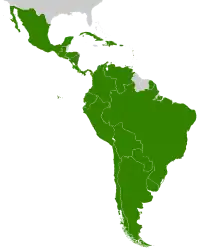Culture of the Dominican Republic
The culture of the Dominican Republic is a diverse mixture of different influences from around the world. The Dominican people and their customs have origins consisting predominantly in a European cultural basis, with native Taíno and African influences.[1]
| This article is part of a series on the |
| Culture of the Dominican Republic |
|---|
| Society |
| Symbols |
| Politics |
| Economy |
|
Dominican Republic portal |

The Dominican Republic was the site of the first European settlement in the Western Hemisphere, namely Santo Domingo founded in 1493. As a result of over five centuries of Spanish presence in the island, the core of Dominican culture is derived from the culture of Spain. The European inheritances include ancestry, language, traditions, law, the predominant religion and the colonial architectural styles. Soon after the arrival of Europeans, African people were imported to the island to serve as slave labor. The fusion of European, native Taino, and African traditions and customs contributed to the development of present-day Dominican culture.
Language
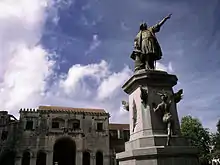
Spanish is the official language in the Dominican Republic. The country has a variety of accents most of which derive from the Spanish spoken in the Canary Islands and western Andalusia of southern Spain. The accent spoken in the Cibao region is a mixture of two dialects: that of the 16th- and 17th-century Portuguese colonists in the Cibao valley, and that of the 18th-century Canarian settlers. Dominican Spanish also has borrowed vocabularies from the Arawak language. Some common words derived from the Taino natives include: barbecue, canoe, caribbean, hammock, hurricane, iguana, manatee, mangrove, savannah, and tobacco among others.
Schools in the Dominican Republic are based on a Spanish educational model. Both English and French are taught as secondary languages on private and public schools. Haitian Creole is spoken by the population of Haitian origin. There is a community of about 8,000 speakers of Samaná English in the Samaná Peninsula. They are the descendants of formerly enslaved Africans who arrived in the nineteenth century. Tourism, American pop culture, the influence of Dominican Americans, and the country's economic ties with the United States motivates other Dominicans to learn English.
Religion
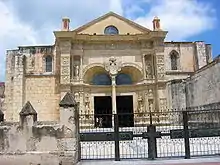
The Dominican Republic is 68.9% Roman Catholic, 18.2% Evangelical, 10.6% with no religion, and 2.3% other.[2] Recent immigration, as well as proselytizing, has brought other religions, with the following shares of the population: Spiritist: 2.2%,[3] The Church of Jesus Christ of Latter-day Saints: 1.1%,[4] Buddhist: 0.1%, Baháʼí: 0.1%,[3] Chinese Folk Religion: 0.1%,[3] Islam: 0.02%, Judaism: 0.01%. The nation has two patroness saints: Nuestra Señora de la Altagracia (Our Lady Of High Grace) and Nuestra Señora de las Mercedes (Our Lady Of Mercy).
The Catholic Church began to lose popularity in the late 19th century. This was due to a lack of funding, of priests, and of support programs. During the same time, the Protestant evangelical movement began to gain support. Religious tension between Catholics and Protestants in the country has been rare.
There has always been religious freedom throughout the entire country. Not until the 1950s were restrictions placed upon churches by Trujillo. Letters of protest were sent against the mass arrests of government adversaries. Trujillo began a campaign against the church and planned to arrest priests and bishops who preached against the government. This campaign ended before it was even put into place, with his assassination.
During World War II, a group of Jews escaping Nazi Germany fled to the Dominican Republic and founded the city of Sosúa. It has remained the center of the Jewish population since.[5]
Music
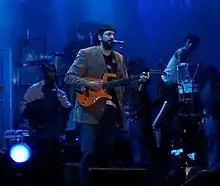
Musically, the Dominican Republic is known for the creation of multiple musical styles and genres but is mostly recognized for merengue, a type of lively, fast-paced rhythm and dance music consisting of a tempo of about 120 to 160 beats per minute (though it varies) based on musical elements like African drums, brass, piano, chorded instruments, and traditionally the accordion, as well as some elements unique to the Dominican Republic, such as the tambora and güira. Its syncopated beats use Latin percussion, brass instruments, bass, and piano or keyboard. Between 1937 and 1950 merengue music was promoted internationally by Dominican groups like Chapuseaux and Damiron "Los Reyes del Merengue", Joseito Mateo, and others. Radio, television, and international media popularized it further. Some well-known merengue performers include Johnny Ventura, singer/songwriter Juan Luis Guerra, Fernando Villalona, Eddy Herrera, Sergio Vargas, Toño Rosario, Milly Quezada, and Chichí Peralta. Merengue became popular in the United States, mostly on the East Coast, during the 1980s and 1990s,[6]: 375 when many Dominican artists, among them Victor Roque y La Gran Manzana, Henry Hierro, Zacarias Ferreira, Aventura, and Milly Jocelyn Y Los Vecinos, residing in the U.S. (particularly New York) started performing in the Latin club scene and gained radio airplay. The emergence of bachata, along with an increase in the number of Dominicans living among other Latino groups in New York, New Jersey, Florida and Massachusetts contributed to Dominican music's overall growth in popularity.[6]: 378

Bachata, a form of music and dance that originated in the countryside and rural marginal neighborhoods of the Dominican Republic, has become quite popular in recent years. Its subjects are often romantic; especially prevalent are tales of heartbreak and sadness. In fact, the original name for the genre was amargue ("bitterness", or "bitter music", or blues music), until the rather ambiguous (and mood-neutral) term bachata became popular. Bachata grew out of, and is still closely related to, the pan-Latin American romantic style called bolero. Over time, it has been influenced by merengue and by a variety of Latin American guitar styles.

Palo is an Afro-Dominican sacred music that can be found through the island. The drum and human voice are the principal instruments. Palo is played at religious ceremonies - usually coinciding with saint's days - as well as for secular parties and special occasions. Its roots are in the Congo region of central-west Africa, but it is mixed with European influences in the melodies. Palos are related to Dominican folk Catholicism, which includes a pantheon of deities/saints (here termed misterios) much like those found in the African derived syncretic religious traditions of Cuba, Brazil, Haiti, and elsewhere. Palos are usually associated with the lower class, black and mixed populations. They can be seen in different regions of the Dominican Republic, but with variations.[7]
Salsa music has had a great deal of popularity in the country. During the late 1960s Dominican native Johnny Pacheco, creator of the famed Fania All Stars, played a significant role in the music's development and popularization, and is also credited for coining the term "Salsa" to denote the genre.
Dominican rock is also popular among younger and not so younger crowds of the Dominican Republic. Dominican rock is influenced by British and American rock, but also has its own sense of unique style. The rock scene in the Dominican Republic has been very vibrant in recent years, spanning genres of rock such as pop rock, reggae/rock, and punk. There are also several underground Metal concerts occurring occasionally mainly in the cities of Santo Domingo and Santiago, where teenagers and young adults usually not satisfied with the other genres express themselves.
Cuisine

Dominican Republic cuisine is predominantly made up of a combination of Spanish, indigenous Taíno, and African influences. Many Middle-Eastern dishes have been adopted into Dominican cuisine, such as the "Quipe" that comes from the Lebanese kibbeh. Dominican cuisine resembles that of other countries in Latin America, those of the nearby islands of Puerto Rico and Cuba, most of all, though the dish names differ sometimes.
A traditional breakfast would consist of mangú, sauteed onions, fried eggs, fried salami, fried cheese and sometimes avocado. This is called "Los Tres Golpes" or "The Three Hits". As in Spain, the largest, most important meal of the day is lunch. Its most typical form, nicknamed La Bandera ("The Flag"), consists of rice, red beans and meat (beef, chicken, pork, or fish), sometimes accompanied by a side of salad.
Meals tend to favor meats and starches over dairy products and vegetables. Many dishes are made with sofrito, which is a mix of local herbs used as a wet rub for meats and sautéed to bring out all of a dish's flavors. Throughout the south-central coast, bulgur, or whole wheat, is a main ingredient in quipes or tipili (bulgur salad).
Other favorite Dominican foods are chicharrón, yuca, casabe, pastelitos (empanadas), batata, yam, chaca (also called maiz caqueao/casqueado, maiz con dulce and maiz con leche), chimichurris, tostones. Some treats Dominicans enjoy are arroz con leche (or arroz con dulce), bizcocho dominicano (lit. Dominican cake), habichuelas con dulce, flan, frío frío (snow cones), dulce de leche, and caña (sugarcane). The beverages Dominicans enjoy include Morir Soñando, rum, beer, Mama Juana, batida (smoothie), jugos naturales (freshly squeezed fruit juices), mabí, and coffee.
Sports

Baseball is by far the most popular sport in the Dominican Republic. The country has a baseball league of six teams. The Milwaukee Brewers have a summer league here called the baseball academy.[8] The baseball season usually begins during October and ends in January. After the United States, the Dominican Republic has the second-highest number of Major League Baseball (MLB) players. Ozzie Virgil, Sr. became the first Dominican-born player in the MLB on September 23, 1956. Juan Marichal is the first Dominican-born player in the Baseball Hall of Fame.[9]
The three highest paid baseball players of all time Alex Rodriguez, Albert Pujols, and Robinson Canó are of Dominican descent. Other notable baseball players from the Dominican Republic are: Julián Javier, Pedro Martínez, Francisco Liriano, Manny Ramírez, José Bautista, Hanley Ramírez, David Ortiz, Ubaldo Jiménez, José Reyes, Alcides Escobar, Plácido Polanco and Sammy Sosa. Felipe Alou has also enjoyed success as a manager,[10] and Omar Minaya as a general manager. In 2013, the Dominican team went undefeated en route to winning the World Baseball Classic.
In boxing, the Dominican Republic has produced scores of world-class fighters and several world champions.[11] Basketball also enjoys a relatively high level of popularity. Al Horford, Felipe Lopez, and Francisco Garcia are among the Dominican-born players currently or formerly in the National Basketball Association (NBA). Olympic gold medalist and world champion hurdler Félix Sánchez hails from the Dominican Republic, as does NFL defensive end Luis Castillo.[12]
Other important sports include, Volleyball, which was introduced in 1916 by US Marines, is controlled by the Dominican Volleyball Federation. Other sports include taekwondo, in which Gabriel Mercedes is an Olympic silver medalist, and judo.[13]
Architecture
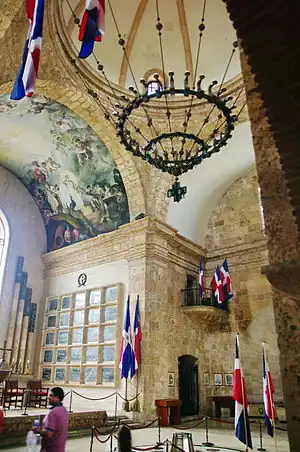
The architecture in the Dominican Republic represents a complex blend of diverse cultures. The deep influence of the European colonists is the most evident throughout the country. Characterized by ornate designs and baroque structures, the style can best be seen in the capital city of Santo Domingo, which is home to the first cathedral, castle, monastery, and fortress in all of the Americas, located in the city's Colonial Zone, an area declared as a World Heritage Site by UNESCO.[14][15] The designs carry over into the villas and buildings throughout the country. It can also be observed on buildings that contain stucco exteriors, arched doors and windows, and red tiled roofs.
The indigenous peoples of the Dominican Republic have also had a significant influence on the architecture of the country. The Taino people relied heavily on the mahogany and guano (dried palm tree leaf) to put together crafts, artwork, furniture, and houses. Utilizing mud, thatched roofs, and mahogany trees give buildings and the furniture inside a natural look, seamlessly blending in with the island's surroundings.
Lately, with the rise in tourism and increasing popularity as a Caribbean vacation destination, architects in the Dominican Republic have now began to incorporate cutting-edge designs that emphasized luxury. In many ways an architectural playground, villas and hotels implemented new styles, while still offering new takes on the old.

This new style, though diverse, is characterized by simplified, angular corners, and large windows that blend outdoor and indoor spaces. As with the culture as a whole, contemporary architects embrace the Dominican Republic's rich history and various cultures to create something new. Surveying modern villas, one can find any combination of the three major styles: a villa may contain angular, modernist building construction, Spanish Colonial-style arched windows, and a traditional Taino hammock in the bedroom balcony.
Visual arts
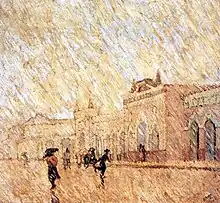
Dominican art is perhaps most commonly associated with the bright, vibrant colors and images that are sold in every tourist gift shop across the country. However, the country has a long history of fine art that goes back to the middle of the 1800s when the country became independent and the beginnings of a national art scene emerged.
Historically, the painting of this time were centered around images connected to national independence, historical scenes, portraits but also landscapes and images of still life. Styles of painting ranged between neoclassicism and romanticism. Between 1920 and 1940 the art scene was influenced by styles of realism and impressionism. Dominican artists were focused on breaking from previous, academic styles in order to develop more independent and individual styles. The artists of the times were Celeste Woss y Gil (1890–1985), Jaime Colson (1901–1975), Yoryi O. Morel (1906–1979) and Darío Suro (1917–1997).
The 1940s represent an important period in Dominican art. President Rafael Leónidas Trujillo provided asylum for Spanish Civil War refugees and a group of Europeans (including famous artists) subsequently arrived to the DR. They became an inspiration to young Dominican artists who were given a more international perspective on art. The art school Escuela Nacional de Bellas Artes was founded as the first official center for teaching art. The country went through a renaissance heavily inspired by the trends happening in Europe.
Between 1950 and 1970 Dominican art expressed the social and political conditions of the time. A need for a renewal of the image language emerged and, as a result, paintings were created in non-figurative, abstract, geometric and cubistic styles. The most notable artists included Paul Giudicelli (1921–1965), Clara Ledesma (1924–1999), Gilberto Hernandez Ortega (1924–1979), Gaspar Mario Cruz (1925–2006), Luichy M. Richiez (1928–2000), Eligio Pichardo (1929–1984), Domingo Liz (b. 1931), Silvano Lora (1934–2003), Cándido Bidó (1936–2011) and José Ramírez Conde (1940–1987).
During the 1970s and 1980s artists were experimenting again with new styles, forms, concepts and themes. Artists such as Ada Balcácer (b. 1930), Fernando Peña Defilló (b. 1928) and Ramón Oviedo (b. 1927) count as the most influential of the decade.
Cinema
Dominican cinema is an emerging film industry, being one of the first countries in Latin America where the Lumière brothers first brought the Curiel theater in San Felipe de Puerto Plata at the beginning of the century in the year 1900, with the industry's beginnings dating back to 1915 in which the first film is produced in Dominican territory.
The Dominican Film Market is officially the first film market in the history of the Caribbean Region, DFM was created and produced by filmmakers Roddy Pérez and Nurgul Shayakhmetova, executives of Audiovisual Dominicana. In its first edition, DFM had the support of important international brands such as Panasonic, Nikon and Blackmagic Design, as well as the co-sponsorship of the Directorate General of Cinema DGCINE, the Center for Export and Investment of the Dominican Republic CEI-RD and the Ministry of Tourism of the Dominican Republic.
Fashion

In only seven years, the Dominican Republic's fashion week has become the most important event of its kind in all of the Caribbean and one of the fastest growing fashion events in the entire Latin American fashion world. The country boasts one of the ten most important design schools in the region, La Escuela de Diseño de Altos de Chavón, which is making the country a key player in the world of fashion and design.
World-famous fashion designer Oscar de la Renta was born in the Dominican Republic in 1932 and became a US citizen in 1971. He studied under the leading Spaniard designer Cristóbal Balenciaga and then worked with the house of Lanvin in Paris. Then by 1963, de la Renta had designs carrying his own label. After establishing himself in the US, de la Renta opened boutiques across the country. His work blends French and Spaniard fashion with American styles.[17][18]
Although he settled in New York, de la Renta also marketed his work in Latin America where it became very popular. He remained active in his native Dominican Republic, where his charitable activities and personal achievements earned him the Juan Pablo Duarte Order of Merit and the Order of Cristóbal Colón.[18]
Fashion designer Jenny Polanco was known for women's clothing and handbags that incorporated Dominican and Caribbean influences into her designs.[19][20]
Festivals

Carnival celebrations are held in the Dominican Republic each February with parades, street dancing, food festivals, and music. Festivities also take place in the week leading up to Easter Sunday. Parades, beauty pageants, and different festivals in each town throughout the country fill the week. In June the country celebrates Espíritu Santo to honor the island's multi-ethnic heritage with nationwide festivals featuring traditional music.

Concerts, dance troupes, arts and crafts booths, and chefs also celebrate Dominican heritage with an annual cultural festival in Puerto Plata each June. Fiesta Patria de la Restauración, or Restoration Day, celebrates the Dominican Republic's day of independence from Spain, which occurred in 1863. Nationwide events include parades, music festivals, street festivals, and food festivals.
Three days each June are set aside for the Latin Music Festival in Santo Domingo. Both local and international Latin musicians and bands take the stage. During the last week of July and first week of August Santo Domingo hosts some of the world's top merengue bands at the Festival del Merengue. Other events during the two-week-long party include and food festival and an arts and crafts festival.
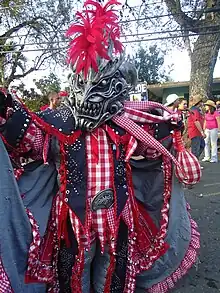
The merengue festival takes place in July in both Santo Domingo and Puerto Plata.[21] This week-long bacchanal raises the ''merengue'' and the costumes worn by the dancers to an art form. The dancers dance in the street and on open stages and compete for an array of honors that recognize originality, fluidity, and beauty of the choreography. Posters that are designed to advertise the festival compete for originality and beauty. The crowds who come to watch the dancing and the parades that take place in the evening also dance.
October's Puerto Plata Festival brings musicians from around the country together to perform live music in a variety of genres. Blues, jazz, folk, salsa, and merengue are the most common. Another musical event takes place in October during Columbus Day Weekend: the Dominican Republic Jazz Festival. Concerts are held in Puerto Plata, Sosua, and Cabarete, and feature some of the country's top jazz musicians and bands.
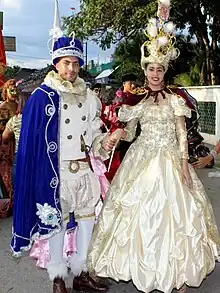
Other festivals include the Festivales del Santo Cristo de Bayaguana on New Year's Day. Events leading up to Mass include a parade, music, and dance. Each January the Dominican Republic honors Juan Pablo Duarte with gun salutes in Santo Domingo and numerous carnivals throughout the country. Duarte is celebrated as the man who gained independence from Haiti for the Dominican Republic. The premier culinary event in all of the Caribbean is Taste SD, which takes place in October of each year.
During the event, hundreds of restaurants, food vendors, chefs, and others on the culinary scene host a series of presentations, tastings, and more. The event stretches out over several days and venues and is known to attract several thousand guests. The main event, unveiled in 2012, is the Culinary Cup of the Americas in which chefs participate in several cooking and baking events hoping to win the top prize. Another event is the Dominican Republic International Film Festival. During four days each December, independent films, shorts, and documentaries are screened.
Holidays
| Date | Name | |
|---|---|---|
| January 1 | New Year's Day | Non-working day. |
| January 6 | Catholic day of the Epiphany | Movable. |
| January 21 | Día de la Altagracia | Non-working day. Patroness Day (Catholic). |
| January 26 | Duarte's Day | Movable. Founding Father. |
| February 27 | Independence Day | Non-working day. National Day. |
| (Variable date) | Holy Week | Working days, except Good Friday. A Catholic holiday. |
| May 1 | International Workers' Day | Movable. |
| Last Sunday of May | Mother's Day | |
| (Variable date) | Catholic Corpus Christi | Non-working day. A Thursday in May or June (60 days after Easter Sunday). |
| August 16 | Restoration Day | Non-working day. |
| September 24 | Virgen de las Mercedes | Non-working day. A Patroness Day (Catholic) |
| November 6 | Constitution Day | Movable. |
| December 25 | Christmas Day | Non-working day. |
Notes:
- Non-working holidays are not moved to another day.
- If a movable holiday falls on Saturday, Sunday or Monday then it is not moved to another day. If it falls on Tuesday or Wednesday, the holiday is moved to the previous Monday. If it falls on Thursday or Friday, the holiday is moved to the next Monday.
- Roman Catholic religious holidays are not moved to another day.
See also
References
- Esteva Fabregat, Claudio «La hispanización del mestizaje cultural en América» Revista Complutense de Historia de América, Universidad Complutense de Madrid. p. 133 (1981)
- "2010 Report on International Religious Freedom – Dominican Republic". Retrieved March 30, 2011.
- "Religious Freedom Page". religiousfreedom.lib.virginia.edu. Archived from the original on June 17, 2008. Retrieved February 27, 2009.
- "Country Profiles > Dominican Republic". churchofjesuschrist.org. 2010. Retrieved January 9, 2010.
- Haggerty, Richard (1989). "Dominican Republic – Religion". Dominican Republic: A Country Study. U.S. Library of Congress. Retrieved May 21, 2006.
- Harvey, Sean (2006). The Rough Guide to The Dominican Republic. Rough Guides. ISBN 1-84353-497-5.
- Palo Drum: Afro-Dominican Tradition
- "Liga de Béisbol Profesional de la República Dominicana" (in Spanish). Archived from the original on 2008-06-10. Retrieved January 20, 2010.
- "Marichal, Juan". Baseball Hall of Fame. Retrieved July 29, 2010.
- Puesan, Antonio (March 2, 2009). "Dominicana busca corona en el clásico mundial". Sobre el Diamante. Archived from the original on January 16, 2013. Retrieved October 22, 2012.
- Fleischer, Nat; Andre, Sam; Rafael, Don (2002). An Illustrated History of Boxing. Citadel Press. pp. 324, 362, 428. ISBN 0-8065-2201-1.
- Shanahan, Tom (March 24, 2007). "San Diego Hall of Champions – Sports at Lunch, Luis Castillo and Felix Sanchez". San Diego Hall of Champions. Archived from the original on May 5, 2007. Retrieved May 29, 2007.
- "Fedujudo comparte con dirigentes provinciales". Federación Dominicana de Judo. Archived from the original on January 6, 2010. Retrieved September 15, 2010.
- Colonial City of Santo Domingo - UNESCO World Heritage Centre
- Comisiones Nacionales: UNESCO
- Cordero, Walter (January–June 2003). Arthur, Víctor (ed.). "El Bohío Dominicano: de lo Real a lo Simbólico". Clío (in Spanish). Imprenta J.R. vda. García, sucs.: Academia Dominicana de la Historia. 71 (165): 105, 126–127. Retrieved 15 June 2015.
- Fashion: Oscar de la Renta (Dominican Republic) Archived 2013-01-16 at the Wayback Machine WCAX.com – Retrieved October 31, 2012.
- Oscar de la Renta. Encyclopædia Britannica. Retrieved October 31, 2012.
- Roberts, Sam (2020-03-27). "Jenny Polanco, Fashion Designer with a Caribbean Palette, Dies at 62". The New York Times. Archived from the original on 2020-03-29. Retrieved 2020-03-30.
- Acevedo, Nicole (2020-03-25). "Jenny Polanco, acclaimed Dominican fashion designer, dies of coronavirus". NBC News. Yahoo News. Archived from the original on 2020-03-25. Retrieved 2020-03-30.
- Brown, Isabel Zakrzewski (1999). Culture and Customs of the Dominican Republic. Westport, CT: Greenwood Press. pp. 101. ISBN 0-313-30314-2.
External links
- Island Thresholds, Peabody Essex Museum's interactive feature, showcases the work of contemporary Caribbean artists and their exploration of identity, culture, and social justice. (requires Macromedia Flash Player)
- Dominican People and Culture
.jpg.webp)

